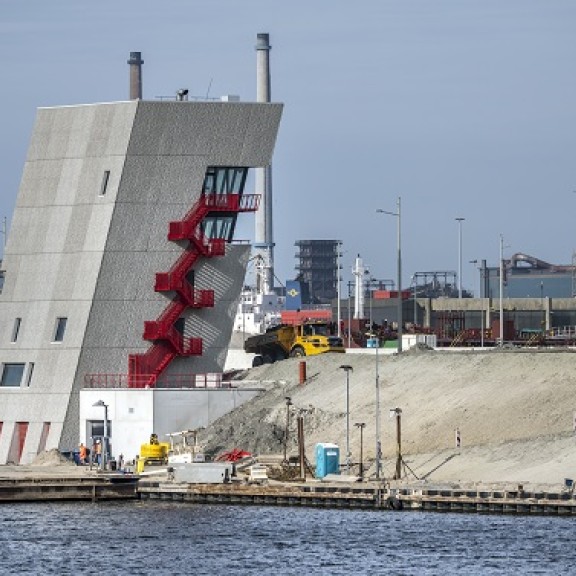
Working together to train lock and VTS operators
Zeesluis IJmuiden will soon be ready for use. But first, staff will have to master the ins and outs of operating the lock. Mia Dröge is Strategic Advisor to the Harbour Master's Division of Port of Amsterdam. Together with a team, she will ensure that the lock can be operated safely.
This includes the training of the VTS operators and the lock operators who will soon be operating the new lock. Mia sees herself as a connector of the various parties within and outside Port of Amsterdam. She talks about her role and activities.
Port of Amsterdam has assigned a number of public tasks to the Harbour Master's Division. These tasks include the handling of shipping traffic. The Harbour Master's Division will ultimately be the organisation that will use the lock to give ships access to the ports in the North Sea Canal area. It is the Harbour Master's task to handle shipping traffic to and from the lock safely, smoothly and sustainably. Many steps will still have to be taken before that can be realised. Mia explained, “The putting into operational service of the new lock involves a lot of preparations. The process starts with a large amount of paperwork, such as the updating of regulations and the making of working agreements with Rijkswaterstaat, the owner of the lock. For example, we need to draw up a new regulation that controls combined lockages through Zeesluis IJmuiden and the parameters of this regulation must be integrated into Port of Amsterdam's digital system. The system will then inform the customers of the port that the lock exists ‘in digital form’. This enables them to send us the required notifications of their ships’ arrivals or departures and it enables us to make lock reservations for Zeesluis IJmuiden.”
The common interest is paramount
In order to make the best possible use of Zeesluis IJmuiden, Mia works together with many different parties. Relations between organisations are good and levels of engagement have increased over time. Mia added, “We work together with different departments of Rijkswaterstaat, with OpenIJ and with the nautical service providers such as the Pilot Organisation, the IJmuiden linesmen and the towing service. We have consultations every four weeks. During these consultations, we discuss the progress of the work. We have been working together for so long that I also call every week to see how things are going. The lines are very short.” Our cooperation, Mia is happy to say, is very pleasant and we can discuss everything. Mia added, “Despite the physical limitations of working from home, we can easily contact each other. I am not afraid to ask critical questions and raise subjects. Even ‘uncomfortable’ issues can be discussed. I look at the common interest of all parties and the willingness to cooperate and move towards a solution. That is a good basis from which to work.”
Working together for the same goal
The various different parties share the same goal: to put the lock into operation effectively and safely. The lock operators and the VTS operators are being trained to operate the new lock. Mia is busy with this. Mia said, “The process is focussed on the lock operators. They are the ones who will actually open and close the lock. The lock operators receive training through e-learning combined with simulations and training in practice. One of the reasons is that the technology of Zeesluis IJmuiden differs from that of the North Lock. The new sea lock is so large that there is no direct view of the moving parts of the lock (barriers and lock gates, for example) from the Lock Operation Centre. That is why cameras are used, so the lock is actually remotely controlled. The lock operators operate all the locks of the lock complex and Zeesluis IJmuiden will soon be added to their set of tasks. Once all the lock operators have mastered the technology of Zeesluis IJmuiden, the VTS operators and other nautical staff will be trained. Their training, though, is less extensive.
Practising with test scenarios
To make sure that everyone is ready for the lock being put into operational service, exercises will be held with Zeesluis IJmuiden this autumn. This will again be done in cooperation with Rijkswaterstaat and OpenIJ. Mia explained that for these exercises, real ships will be used for the lockage process. Mia added, “We are going to test the entire lock process of Zeesluis IJmuiden together with the lock operators, the pilots, the tugboats and the linesmen. We will do this with ships of various sizes, including ships that are already scheduled to call at one of the ports in the North Sea Canal area. We will ask these ships in advance if they are willing to participate in the lock process tests by passing through Zeesluis IJmuiden. During the test period, the other locks will also be operated of course. An increased number of staff will therefore be on duty then. The test period is the final test for all cooperating parties: the builder of the lock (OpenIJ), the owner of the lock (Rijkswaterstaat), the user of the lock (the Harbour Master's Division), and the nautical service providers who assist the ships passing through the lock. Ultimately, Zeesluis IJmuiden must be a safe place for everyone and we must be able to work safely together.’